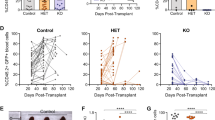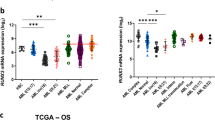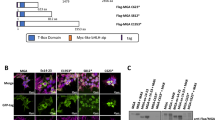Abstract
We have identified a new t(1;21)(p32;q22) chromosomal translocation in a MDS/AML patient that results in expression of an aberrant C-terminally truncated RUNX1 protein lacking several regulatory domains. As similar truncated RUNX1 proteins are generated by genetic aberrations including chromosomal translocations and point mutations, we used the t(1;21)(p32;q22) chromosomal translocation as a model to explore whether C-terminally truncated RUNX1 proteins trigger effects similar to those induced by well-characterized leukemogenic RUNX1 fusion genes. In vitro analysis of transduced human hematopoietic/progenitor stem cells showed that truncated RUNX1 proteins increase proliferation and self-renewal and disrupt the differentiation program by interfering with RUNX1b. These effects are similar to but milder than those induced by the RUNX1/ETO fusion protein. GSEA analysis confirmed similar altered gene expression patterns in the truncated RUNX1 and RUNX1/ETO models, with both models showing alterations in genes involved in self-renewal and leukemogenesis, including homeobox genes, primitive erythroid genes and leukemogenic transcription factors. We propose that C-terminally truncated RUNX1 proteins can contribute to leukemogenesis in a similar way to RUNX1 fusion genes but through a milder phenotype.
This is a preview of subscription content, access via your institution
Access options
Subscribe to this journal
Receive 50 print issues and online access
$259.00 per year
only $5.18 per issue
Buy this article
- Purchase on Springer Link
- Instant access to full article PDF
Prices may be subject to local taxes which are calculated during checkout




Similar content being viewed by others
References
Gilliland DG, Jordan CT, Felix CA . The molecular basis of leukemia. Hematology Am Soc Hematol Educ Program 2004: 80–97.
Friedman AD . Cell cycle and developmental control of hematopoiesis by Runx1. J Cell Physiol 2009; 219: 520–524.
Niebuhr BB, Fischer MM, Täger MM, Cammenga JJ, Stocking CC . Gatekeeper function of the RUNX1 transcription factor in acute leukemia. Blood Cells Mol Dis 2008; 40: 8–8.
Miyoshi H, Shimizu K, Kozu T, Maseki N, Kaneko Y, Ohki M . t(8;21) breakpoints on chromosome 21 in acute myeloid leukemia are clustered within a limited region of a single gene, AML1. Proc Natl Acad Sci USA 1991; 88: 10431–10434.
Hayashi KK, Natsume WW, Watanabe TT, Abe NN, Iwai NN, Okada HH et al. Diminution of the AML1 transcription factor function causes differential effects on the fates of CD4 and CD8 single-positive T cells. J Immunol 2000; 165: 6816–6824.
Kurokawa MM, Hirai HH . Role of AML1/Runx1 in the pathogenesis of hematological malignancies. Cancer Sci 2003; 94: 841–846.
Miyoshi OSMHIYSO. Alternative splicing and genomic structure of the AML1 gene involved in acute myeloid leukemia. Nucleic Acid Res 1995; 23: 1–8.
Liu X, Zhang Q, Zhang DE, Zhou C, Xing H, Tian Z et al. Overexpression of an isoform of AML1 in acute leukemia and its potential role in leukemogenesis. Leukemia 2009; 23: 739–745.
Tanaka T, Tanaka K, Ogawa S, Kurokawa M, Mitani K, Nishida J et al. An acute myeloid leukemia gene, AML1, regulates hemopoietic myeloid cell differentiation and transcriptional activation antagonistically by two alternative spliced forms. EMBO J 1995; 14: 341–350.
Tsuzuki S, Hong D, Gupta R, Matsuo K, Seto M, Enver T . Isoform-specific potentiation of stem and progenitor cell engraftment by AML1/RUNX1. PLoS Med 2007; 4: e172.
Osato M . Point mutations in the RUNX1/AML1 gene: another actor in RUNX leukemia. Oncogene 2004; 23: 4284–4296.
Schnittger S, Dicker F, Kern W, Wendland N, Sundermann J, Alpermann T et al. RUNX1 mutations are frequent in de novo AML with noncomplex karyotype and confer an unfavorable prognosis. Blood 2011; 117: 2348–2357.
Osato M, Yanagida M, Shigesada K, Ito Y . Point mutations of the RUNx1/AML1 gene in sporadic and familial myeloid leukemias. Int J Hematol 2001; 74: 245–251.
Taketani T, Taki T, Takita J, Tsuchida M, Hanada R, Hongo T et al. AML1/RUNX1 mutations are infrequent, but related to AML-M0, acquired trisomy 21, and leukemic transformation in pediatric hematologic malignancies. Genes Chromosomes Cancer 2003; 38: 1–7.
Harada H, Harada Y, Niimi H, Kyo T, Kimura A, Inaba T . High incidence of somatic mutations in the AML1/RUNX1 gene in myelodysplastic syndrome and low blast percentage myeloid leukemia with myelodysplasia. Blood 2004; 103: 2316–2324.
Dicker F, Haferlach C, Kern W, Haferlach T, Schnittger S . Trisomy 13 is strongly associated with AML1/RUNX1 mutations and increased FLT3 expression in acute myeloid leukemia. Blood 2007; 110: 1308–1316.
Silva FPG, Lind A, Brouwer-Mandema G, Valk PJM, Giphart-Gassler M . Trisomy 13 correlates with RUNX1 mutation and increased FLT3 expression in AML-M0 patients. Haematologica 2007; 92: 1123–1126.
Roumier C, Eclache V, Imbert M, Davi F, MacIntyre E, Garand R et al. M0 AML, clinical and biologic features of the disease, including AML1 gene mutations: a report of 59 cases by the Groupe Français d'Hématologie Cellulaire (GFHC) and the Groupe Français de Cytogénétique Hématologique (GFCH). Blood 2003; 101: 1277–1283.
Preudhomme C, Warot-Loze D, Roumier C, Grardel-Duflos N, Garand R, Lai JL et al. High incidence of biallelic point mutations in the Runt domain of the AML1/PEBP2 alpha B gene in Mo acute myeloid leukemia and in myeloid malignancies with acquired trisomy 21. Blood 2000; 96: 2862–2869.
Osato M, Asou N, Abdalla E, Hoshino K, Yamasaki H, Okubo T et al. Biallelic and heterozygous point mutations in the runt domain of the AML1/PEBP2alphaB gene associated with myeloblastic leukemias. Blood 1999 15 93: 1817–1824.
Song WJ, Sullivan MG, Legare RD, Hutchings S, Tan X, Kufrin D et al. Haploinsufficiency of CBFA2 causes familial thrombocytopenia with propensity to develop acute myelogenous leukaemia. Nat Genet 1999; 23: 166–175.
Yamagata T, Maki K, Mitani K . Runx1/AML1 in normal and abnormal hematopoiesis. Int J Hematol 2005; 82: 1–8.
Tang J-L, Hou H-A, Chen C-Y, Liu C-Y, Chou W-C, Tseng M-H et al. AML1/RUNX1 mutations in 470 adult patients with de novo acute myeloid leukemia: prognostic implication and interaction with other gene alterations. Blood 2009; 114: 5352–5361.
Chen C-Y, Lin L-I, Tang J-L, Ko B-S, Tsay W, Chou W-C et al. RUNX1 gene mutation in primary myelodysplastic syndrome—the mutation can be detected early at diagnosis or acquired during disease progression and is associated with poor outcome. Br J Haematol 2007; 139: 405–414.
Hagemeijer A, Garson OM, Kondo K . Fourth International Workshop on Chromosomes in Leukemia 1982: Translocation (8;21)(q22;q22) in acute nonlymphocytic leukemia. Cancer Genet Cytogenet 1984; 11: 284–287.
Figueroa ME, Lugthart S, Li Y, Erpelinck-Verschueren C, Deng X, Christos PJ et al. DNA methylation signatures identify biologically distinct subtypes in acute myeloid leukemia. Cancer Cell 2010; 17: 13–27.
Alvarez S, Suela J, Valencia A, Fernández A, Wunderlich M, Agirre X et al. DNA methylation profiles and their relationship with cytogenetic status in adult acute myeloid leukemia. PLoS One 2010; 5: e12197.
De Braekeleer E, Douet-Guilbert N, Morel F, Le Bris M-J, Férec C, De Braekeleer M . RUNX1 translocations and fusion genes in malignant hemopathies. Future Oncol 2011; 7: 77–91.
Chinen Y, Taki T, Nishida K, Shimizu D, Okuda T, Yoshida N et al. Identification of the novel AML1 fusion partner gene, LAF4, a fusion partner of MLL, in childhood T-cell acute lymphoblastic leukemia with t(2;21)(q11;q22) by bubble PCR method for cDNA. Oncogene 2008; 27: 2249–2256.
Agerstam H, Lilljebjörn H, Lassen C, Swedin A, Richter J, Vandenberghe P et al. Fusion gene-mediated truncation of RUNX1 as a potential mechanism underlying disease progression in the 8p11 myeloproliferative syndrome. Genes Chromosomes Cancer 2007; 46: 635–643.
Nguyen TT, Ma LN, Slovak ML, Bangs CD, Cherry AM, Arber DA . Identification of novel Runx1 (AML1) translocation partner genes SH3D19, YTHDf2, and ZNF687 in acute myeloid leukemia. Genes Chromosomes Cancer 2006; 45: 918–932.
Stevens-Kroef M-JPL, Schoenmakers EFPM, van Kraaij M, Huys E, Vermeulen S, van der Reijden B et al. Identification of truncated RUNX1 and RUNX1-PRDM16 fusion transcripts in a case of t(1;21)(p36;q22)-positive therapy-related AML. Leukemia 2006; 20: 1187–1189.
Mikhail FM, Coignet L, Hatem N, Mourad ZI, Farawela HM, Kaffash El DM et al. A novel gene, FGA7, is fused to RUNX1/AML1 in a t(4;21)(q28;q22) in a patient with T-cell acute lymphoblastic leukemia. Genes Chromosomes Cancer 2004; 39: 110–118.
Ramsey H, Zhang D-E, Richkind K, Burcoglu-O'Ral A, Hromas R . Fusion of AML1/Runx1 to copine VIII, a novel member of the copine family, in an aggressive acute myelogenous leukemia with t(12;21) translocation. Leukemia 2003; 17: 1665–1666.
Hromas R, Busse T, Carroll A, Mack D, Shopnick R, Zhang DE et al. Fusion AML1 transcript in a radiation-associated leukemia results in a truncated inhibitory AML1 protein. Blood 2001; 97: 2168–2170.
Nucifora G, Begy CR, Erickson P, Drabkin HA, Rowley JD . The 3;21 translocation in myelodysplasia results in a fusion transcript between the AML1 gene and the gene for EAP, a highly conserved protein associated with the Epstein-Barr virus small RNA EBER 1. Proc Natl Acad Sci USA 1993; 90: 7784–7788.
Maki K, Sasaki K, Sugita F, Nakamura Y, Mitani K . Acute myeloid leukemia with t(7;21)(q11.2;q22) expresses a novel, reversed-sequence RUNX1-DTX2 chimera. Int J Hematol 2012; 96: 268–273.
Proudfoot NJ . Ending the message: poly(A) signals then and now. Genes Dev 2011; 25: 1770–1782.
Cherry AM, Bangs CD, Jones P, Hall S, Natkunam Y . A unique AML1 (CBF2 A) rearrangement, t(1;21)(p32;q22), observed in a patient with acute myelomonocytic leukemia. Cancer Genet Cytogenet 2001; 129: 155–160.
Aoki T, Miyamoto T, Yoshida S, Yamamoto A, Yamauchi T, Yoshimoto G et al. Additional acquisition of t(1;21)(p32;q22) in a patient relapsing with acute myelogenous leukemia with NUP98-HOXA9. Int J Hematol 2008; 88: 571–574.
Mulloy JC, Cammenga J, MacKenzie KL, Berguido FJ, Moore MAS, Nimer SD . The AML1-ETO fusion protein promotes the expansion of human hematopoietic stem cells. Blood 2002; 99: 15–23.
Zhang DE, Hetherington CJ, Chen HM, Tenen DG . The macrophage transcription factor PU.1 directs tissue-specific expression of the macrophage colony-stimulating factor receptor. Mol Cell Biol 1994; 14: 373–381.
Wei H, Liu X, Xiong X, Wang Y, Rao Q, Wang M et al. AML1-ETO interacts with Sp1 and antagonizes Sp1 transactivity through RUNT domain. FEBS Lett 2008; 582: 2167–2172.
Maiques-Diaz A, Chou FS, Wunderlich M, Gómez-López G, Jacinto FV, Rodriguez-Perales S et al. Chromatin modifications induced by the AML1-ETO fusion protein reversibly silence its genomic targets through AML1 and Sp1 binding motifs. Leukemia 2012; 26: 1329–1337.
Matsuura S, Komeno Y, Stevenson KE, Biggs JR, Lam K, Tang T et al. Expression of the runt homology domain of RUNX1 disrupts homeostasis of hematopoietic stem cells and induces progression to myelodysplastic syndrome. Blood 2012; 120: 4028–4037.
Christiansen DH, Andersen MK, Pedersen-Bjergaard J . Mutations of AML1 are common in therapy-related myelodysplasia following therapy with alkylating agents and are significantly associated with deletion or loss of chromosome arm 7q and with subsequent leukemic transformation. Blood 2004; 104: 1474–1481.
Mulloy JC, Cammenga J, Berguido FJ, Wu K, Zhou P, Comenzo RL et al. Maintaining the self-renewal and differentiation potential of human CD34+ hematopoietic cells using a single genetic element. Blood 2003; 102: 4369–4376.
Meyers S, Lenny N, Hiebert SW . The t(8;21) fusion protein interferes with AML-1B-dependent transcriptional activation. Mol. Cell. Biol. 1995; 15: 1974–1982.
Uchida H, Zhang J, Nimer SD . AML1A and AML1B can transactivate the human IL-3 promoter. J Immunol 1997; 158: 2251–2258.
Frank R, Zhang J, Uchida H, Meyers S, Hiebert SW, Nimer SD . The AML1/ETO fusion protein blocks transactivation of the GM-CSF promoter by AML1B. Oncogene 1995; 11: 2667–2674.
Rhoades KL, Hetherington CJ, Harakawa N, Yergeau DA, Zhou L, Liu LQ et al. Analysis of the role of AML1-ETO in leukemogenesis, using an inducible transgenic mouse model. Blood 2000; 96: 2108–2115.
Yuan Y, Zhou L, Miyamoto T, Iwasaki H, Harakawa N, Hetherington CJ et al. AML1-ETO expression is directly involved in the development of acute myeloid leukemia in the presence of additional mutations. Proc Natl Acad Sci USA 2001; 98: 10398–10403.
Lawrence HJ, Christensen J, Fong S, Hu Y-L, Weissman I, Sauvageau G et al. Loss of expression of the Hoxa-9 homeobox gene impairs the proliferation and repopulating ability of hematopoietic stem cells. Blood 2005; 106: 3988–3994.
Kawagoe H, Humphries RK, Blair A, Sutherland HJ, Hogge DE . Expression of HOX genes, HOX cofactors, and MLL in phenotypically and functionally defined subpopulations of leukemic and normal human hematopoietic cells. Leukemia 1999; 13: 687–698.
Lawrence HJ, Rozenfeld S, Cruz C, Matsukuma K, Kwong A, Kömüves L et al. Frequent co-expression of the HOXA9 and MEIS1 homeobox genes in human myeloid leukemias. Leukemia 1999; 13: 1993–1999.
Afonja O, Smith JE, Cheng DM, Goldenberg AS, Amorosi E, Shimamoto T et al. MEIS1 and HOXA7 genes in human acute myeloid leukemia. Leuk Res 2000; 24: 849–855.
Drabkin HA, Parsy C, Ferguson K, Guilhot F, Lacotte L, Roy L et al. Quantitative HOX expression in chromosomally defined subsets of acute myelogenous leukemia. Leukemia 2002; 16: 186–195.
Bullinger L, Döhner K, Bair E, Fröhling S, Schlenk RF, Tibshirani R et al. Use of gene-expression profiling to identify prognostic subclasses in adult acute myeloid leukemia. N Eng J Med 2004; 350: 1605–1616.
Yeh J-RJ, Munson KM, Chao YL, Peterson QP, Macrae CA, Peterson RT . AML1-ETO reprograms hematopoietic cell fate by downregulating scl expression. Development 2008; 135: 401–410.
Offit K, Jhanwar SC, Ladanyi M, Filippa DA, Chaganti RS . Cytogenetic analysis of 434 consecutively ascertained specimens of non-Hodgkin's lymphoma: correlations between recurrent aberrations, histology, and exposure to cytotoxic treatment. Genes Chromosomes Cancer 1991; 3: 189–201.
Torres R, Martin MC, Garcia A, Cigudosa JC, Ramirez JC, Rodriguez-Perales S . Engineering human tumour-associated chromosomal translocations with the RNA-guided CRISPR-Cas9 system. Nat Commun 2014; 5: 3964.
Torres R, Garcia A, Jimenez M, Rodriguez S, Ramirez JC . An integration-defective lentivirus-based resource for site-specific targeting of an edited safe-harbour locus in the human genome. Gene Ther 2014; 21: 343–352.
Li Z, Xu M, Xing S, Ho WT, Ishii T, Li Q et al. Erlotinib effectively inhibits JAK2V617F activity and polycythemia vera cell growth. J Biol Chem 2006; 282: 3428–3432.
Acknowledgements
This work was supported by an INTRASALUD project PI 12-00425 to JCC. We thank all the coworkers in our laboratory for their excellent technical assistance.
Author Contributions
SR and MCM performed the genetic, cell culture, cytometry and luciferase experiments; SR, JS and FA performed the genomic experiments; RT and JCR designed and performed qRT–PCR experiments, provided the lentiviral vectors and helped with the transduction experiments; EY provided the bone marrow samples and the clinical information; SA provide the clinical assessment and contributed to the discussion; SR and JCC analyzed the data and wrote the manuscript.
Disclaimer
The funders had no role in study design, data collection and analysis, decision to publish or preparation of the manuscript.
Author information
Authors and Affiliations
Corresponding authors
Ethics declarations
Competing interests
The authors declare no conflict of interest.
Additional information
Supplementary Information accompanies this paper on the Oncogene website
Supplementary information
Rights and permissions
About this article
Cite this article
Rodriguez-Perales, S., Torres-Ruiz, R., Suela, J. et al. Truncated RUNX1 protein generated by a novel t(1;21)(p32;q22) chromosomal translocation impairs the proliferation and differentiation of human hematopoietic progenitors. Oncogene 35, 125–134 (2016). https://doi.org/10.1038/onc.2015.70
Received:
Revised:
Accepted:
Published:
Issue Date:
DOI: https://doi.org/10.1038/onc.2015.70
This article is cited by
-
MTAP-ANRIL gene fusion promotes melanoma epithelial-mesenchymal transition-like process by activating the JNK and p38 signaling pathways
Scientific Reports (2023)
-
The TINCR ubiquitin-like microprotein is a tumor suppressor in squamous cell carcinoma
Nature Communications (2023)
-
In vivo CRISPR/Cas9 targeting of fusion oncogenes for selective elimination of cancer cells
Nature Communications (2020)
-
Functional characterization of two enhancers located downstream FOXP2
BMC Medical Genetics (2019)
-
PAN3–PSMA2 fusion resulting from a novel t(7;13)(p14;q12) chromosome translocation in a myelodysplastic syndrome that evolved into acute myeloid leukemia
Experimental Hematology & Oncology (2018)



